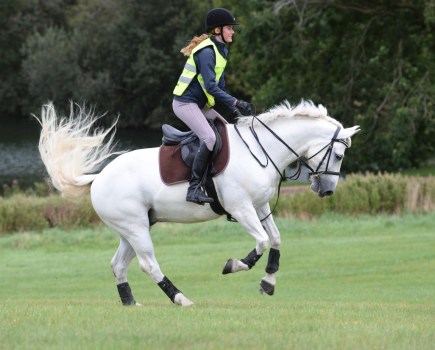Many hacking routes are shared with dog walkers, and some canines will chase, bark at and generally intimidate horses.
It is an offence under section 3 of the Dangerous Dogs Act 1991 for the owner, or other person in charge of a dog, to cause or permit the dog to be dangerously out of control in any place — but we all know that it still happens.
Dogs are predatory animals and like to chase.
Horses are prey animals, programmed to run.
When the two meet instinct can take over, with the dog becoming aggressive or chasing and your horse becoming desperate to flee. Understandable, of course, but also very dangerous.
Numerous incidents of horses being injured and even killed after being spooked by a loose dog have been reported in the press recently, including the tragic case of Loki, who was hit by a car after unseating his rider and bolting on to a road.
Sadly, reports of loose dogs are almost a daily occurrence.
Work is ongoing to tighten legislation so that it better protects horses and riders, but in the meantime, it is important to know what to do in the event that a dog gives chase.
Make decisions, take control
“My rule for riders is to put their safety first, and that of their horse second,” says Jason Webb of Your Horsemanship. “When you meet a loose dog, quickly assess if it’s playing or becoming aggressive.”
If playing, the excitement could escalate if you turn away. Instead, he suggests that you jump off, hold your ground and get noisy to scare it off.
However, “if the dog is behaving aggressively and you trust your horse won’t bolt, don’t get off as they could go for you,” warns Jason.
“If your safety is compromised and there’s a chance your horse will take off, dismount, try to lead them away but be prepared to let go if you need to.
“If your horse bolts, the dog will chase and if you stay on board the ability to control them is limited. Their panic could put you both in danger.”
Circles for calm
“With a non-aggressive but nuisance dog, controlling your horse’s anxiety is key,” explains Jason.
Connect your horse through your body, keeping both legs on. Then use small circles to encourage the anxiety levels to drop.
Ride your horse onto a circle and keep them on it, changing the rein at times if there’s room.
If you’re on a path and riding a circle isn’t achievable, use a narrow figure of eight up and down the path instead, keeping your horse bent to the inside.
“Working on the manoeuvrability of your horse at home gives you confidence you can turn them into a fence or small space if needed without them erupting,” adds Jason.
Make a safety plan
If you spot a loose dog in the distance and you’re concerned, make a plan if you have time.
Can you put a barrier between your horse and the dog? A hedge or fence maybe.
Assess the area for an escape route and, as they get closer, politely ask the owner to grab the dog, explaining why.
“Give your horse time to see the dog, controlling any initial flight response using the circle exercise and positive riding,” says Jason.
“When you’re hacking take every opportunity to chat with owners about how horses and dogs don’t always mix so they know what to do next time.”
Expose your horse to dogs
Hacking isn’t the only place your horse is likely to meet a dog on or off the lead.
They’ll also be around them at shows and it has been known for loose dogs to escape onto cross-country courses to chase horses during their rounds.
As a result, it’s important to do all you can to get your horse used to dogs.
“Introduce your horse to dogs at the yard, in baby steps,” says Jason.
Having dogs around your horse on the yard on a daily basis is an effective way to grow your horse’s confidence.
Jason adds that if you own a dog and plan to take it to your yard, make sure you have the yard owner’s permission.
“Get their permission to have your dog around otherwise your insurance could be invalidated if there’s an incident,” he warns.
If your horse is bitten
A dog bite is potentially a very serious injury, especially if it is on the horse’s joint — and fetlocks are often in the firing line.
If your horse is bitten, get the owner’s name and contact details. If they refuse or become aggressive, make a note of what they’re wearing and the type of dog.
Snap a photo if you can. Even better, always wear a camera out hacking and save the footage as soon as you get home. You should then report the incident to the police immediately.
Lead your horse back to the yard, call the vet and ask them what to do while you wait for them to arrive, such as starting to wash the wound with clean water.
Dog bites can become infected quickly and should be seen by a vet immediately. This is particularly crucial if the bite is on a joint, such as the fetlock )(this is so important that we’re telling you twice).
If your horse is unable to move, call the vet to the scene. Get the dog away from your horse and talk to your horse to keep them calm.
Remember to stay calm yourself.
Report the incident to the BHS using the Horse-i app as well as the police.
Main image © Your Horse Library/Kelsey Media Ltd








